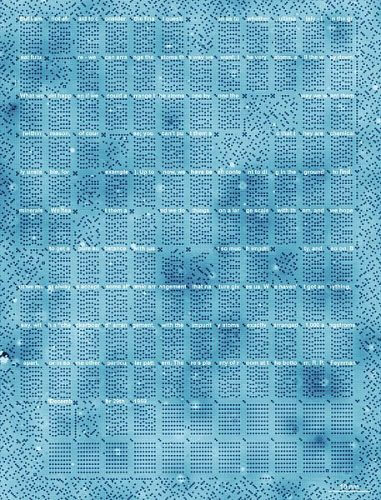The researchers paid tribute to Richard Feynman, who said in the XNUMXs that if we could create a system that would allow us to arrange individual atoms in a very orderly pattern, it would be possible to store a unit of information in each of these atoms

[Translation by Dr. Nachmani Moshe]
A team of scientists from Delft University in the Netherlands managed to develop an atomic unit for storing digital information in a volume 500 times larger than the best hard drive.
Every day, human society generates more than a billion gigabits of new information. In order to store all this information, it is increasingly important that every single bit is required in as little space as possible. A team of scientists from the University of Delft in the Netherlands managed to bring this reduction to the ultimate limit: they created a memory unit with a volume of 1 kilobits represented by the position of a single chlorine atom. "In theory, this storage volume would make it possible to preserve all the books ever written on one postage stamp," said lead researcher Sander Otte. The researchers achieved a storage capacity of 500 terabits per 6 cm, a level 500 times higher than the storage capacity of the best commercial hard drive available today. The research findings have long been published in the scientific journal Nature Nanotechnology.
Richard Feynman
In 1959, physicist Richard Feynman challenged his fellow researchers to model the world on the tiniest scale. During his famous lecture, he predicted that if we could create a system that would allow us to arrange individual atoms in a highly ordered pattern, it would be possible to store a unit of information in each of these atoms. In recognition of Feynman's vision, the team was able to encode part of his lecture on a 100 nanometer surface.
The researchers used a scanning tunneling microscope with the help of which a gauge made of a tiny and extremely thin needle scans the atoms that make up the surface of a defined substrate, atom by atom. With the help of such a microscope the scientists are not only able to see the individual atoms, but they are also able to use a needle to move them from one point to another. "The process can be simulated for moving parts of an attachment," explains the lead researcher. "Each unit of information consists of two positions on the surface of copper atoms, and a single chlorine atom that we can move back and forth between these two positions. If the chlorine atom is in the upper position, a hole forms below it - we call this state 1. If the hole forms in the upper position so that the chlorine atom is in the lower position, we call this state 0. "Since the chlorine atoms are surrounded by other chlorine atoms, except near the holes, they fill One fills the missing place of the other. This is why this method, which is guided by a collection of holes, is much more stable than methods based on a collection of loose atoms, and is therefore more suitable for storing information. The researchers organized their memory units into collections of 8 bits (64 bits). Each of them has a marker, which consists of the same type of "holes" as the other chlorine atoms. Inspired by a two-dimensional QR barcode that is often used to scan airline tickets and concert tickets, these markers function like miniature QR codes that store information about the exact location of the collection of chlorine atoms on the copper layer. The code can also signal a situation where the collection is damaged, for example, due to a specific local contamination or a defect in the surface structure. This feature will make it possible to scale the memory unit easily to much larger volumes, even if the copper surface is not perfect.
The new approach offers great potential in terms of stability and expandability. And yet, this type of memory is not expected to appear on the market in the near future. The researcher explains: "Currently, the memory can only operate under very clean conditions of vacuum and at the temperature reached by liquid nitrogen, so practical storage of data in the form of an atomic array is still very far out of reach. At the same time, this achievement definitely advances us one big step in this direction".

4 תגובות
You wrote collections of 8 bits 64 bits. There should be 8 bytes and not 8 bits
You wrote collections of 8 bits 64 bits. There should be 8 bytes and not 8 bits
You wrote collections of 8 bits 64 bits. There should be 8 bytes and not 8 bits
Stunning